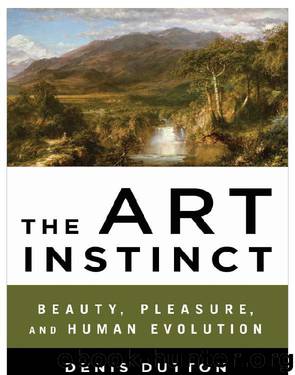The Art Instinct by Denis Dutton

Author:Denis Dutton
Language: eng
Format: mobi, epub
Publisher: Bloomsbury Publishing
Published: 2000-01-01T10:00:00+00:00
CHAPTER 7
Art and Human Self-Domestication
I
The argument of this book has focused so far on the ways in which natural selection throws light on our understanding of natural and artistic beauty. My approach has tended to model the human mind on the analogy of a multipurpose tool—a Swiss Army knife fitted by evolution with an assortment of mental blades and implements for solving specific problems of survival in prehistory. Conceived in this way, our minds evolved for causal and probabilistic reasoning about the normal furniture of the Pleistocene environment: other people, animals, plants, and physical objects. The model brings into the light inclinations and strategies that were selected for in such areas as food preference and avoidance, self-defense, safety, habitat selection, and imaginative planning. In these respects, the multitool pocket knife is an apt analogy, since it stresses the practical survival benefits of specialized interests, passions, dislikes, pleasures, skills, phobias, and intellectual aptitudes.
Conceived in this way, our Pleistocene inheritance gives us an explanation for underlying tendencies in landscape painting and garden design as reflecting deeply ancient habitat preferences. Similarly, the remarkable imaginative capacities of Homo sapiens—along with a persis fascination with subjects such as physical dangers, competition for power, love, or exploration—are crucial to understanding the universality of storytelling. But there is more historically to landscape painting and literature than these factors of natural selection alone can explain. In par tic u lar, my approach has till now has ignored one of the most important features given in the list of criteria for art in chapter 3: skill, style, and a sense of accomplishment—values we admire in art. It is human intelligence and creativity that transforms appealing landscape scenes and plot outlines into works of painterly or literary art.
Natural selection stresses survival in a hostile environment as fundamental to the prehistoric evolution of any adaptation. But if art is an adaptation, mere survival is a completely inadequate explanation for existence. The reason is clear: artistic objects and perperformances are typically among the most opulent, extravagant, glittering, and profligate creations of the human mind. The arts squander brain power, physical effort, time, and precious resources. Natural selection, on the other hand, economical and abstemious: it weeds out inefficiency and waste. The organs and behaviors of animals are designed by natural selection to a species to survive and reproduce, making the most effective use local resources. Evolution by natural selection is a severe accountant way it sorts out potential adaptations in terms of costs and benefits. How strange, therefore, to argue then for a Darwinian genesis of arts of man, which so often tend toward lavish excess, costly far beyond any obvious adaptive benefits for survival.
This problem is not unique to understanding human evolution but general issue in Darwinian theory. The classic case is the peacock’s both Darwin and his early critics well understood. Some initial reluctance by otherwise sympathetic scientists to accept the Origin of Species stemmed from Darwin’s failure to explain nature’s excesses: for example, plumage and songs of birds. Darwin was acutely aware of this difficulty.
Download
This site does not store any files on its server. We only index and link to content provided by other sites. Please contact the content providers to delete copyright contents if any and email us, we'll remove relevant links or contents immediately.
| Anthropology | Archaeology |
| Philosophy | Politics & Government |
| Social Sciences | Sociology |
| Women's Studies |
Cecilia; Or, Memoirs of an Heiress — Volume 1 by Fanny Burney(31322)
Cecilia; Or, Memoirs of an Heiress — Volume 3 by Fanny Burney(30928)
Cecilia; Or, Memoirs of an Heiress — Volume 2 by Fanny Burney(30885)
The Great Music City by Andrea Baker(21195)
We're Going to Need More Wine by Gabrielle Union(18064)
Bombshells: Glamour Girls of a Lifetime by Sullivan Steve(13100)
Pimp by Iceberg Slim(12922)
All the Missing Girls by Megan Miranda(12739)
Fifty Shades Freed by E L James(12443)
Norse Mythology by Gaiman Neil(11873)
Talking to Strangers by Malcolm Gladwell(11861)
Crazy Rich Asians by Kevin Kwan(8340)
Mindhunter: Inside the FBI's Elite Serial Crime Unit by John E. Douglas & Mark Olshaker(7827)
The Lost Art of Listening by Michael P. Nichols(6462)
Enlightenment Now: The Case for Reason, Science, Humanism, and Progress by Steven Pinker(6402)
Bad Blood by John Carreyrou(5761)
The Four Agreements by Don Miguel Ruiz(5502)
Weapons of Math Destruction by Cathy O'Neil(5029)
We Need to Talk by Celeste Headlee(4861)
